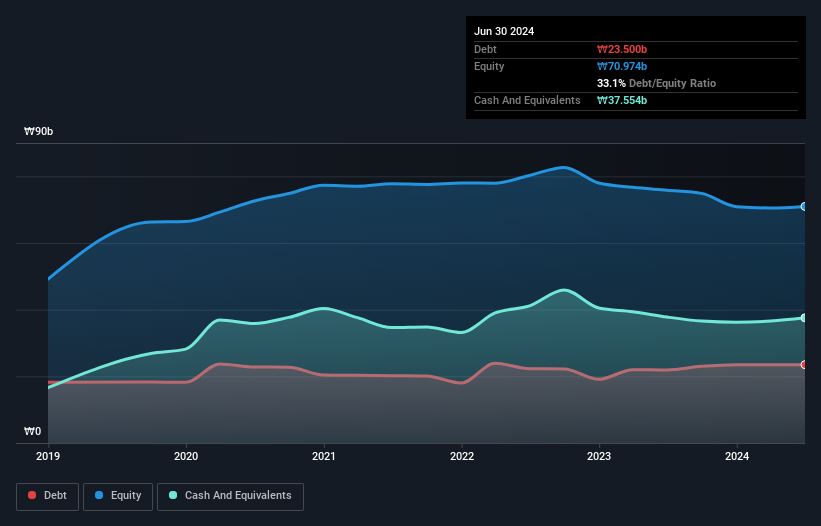- South Korea
- /
- Semiconductors
- /
- KOSDAQ:A256630
Is POINT ENGINEERINGLtd (KOSDAQ:256630) A Risky Investment?
Some say volatility, rather than debt, is the best way to think about risk as an investor, but Warren Buffett famously said that 'Volatility is far from synonymous with risk.' When we think about how risky a company is, we always like to look at its use of debt, since debt overload can lead to ruin. Importantly, POINT ENGINEERING Co.,Ltd. (KOSDAQ:256630) does carry debt. But the more important question is: how much risk is that debt creating?
What Risk Does Debt Bring?
Debt assists a business until the business has trouble paying it off, either with new capital or with free cash flow. If things get really bad, the lenders can take control of the business. However, a more usual (but still expensive) situation is where a company must dilute shareholders at a cheap share price simply to get debt under control. Of course, debt can be an important tool in businesses, particularly capital heavy businesses. The first thing to do when considering how much debt a business uses is to look at its cash and debt together.
View our latest analysis for POINT ENGINEERINGLtd
What Is POINT ENGINEERINGLtd's Debt?
As you can see below, at the end of June 2024, POINT ENGINEERINGLtd had ₩23.5b of debt, up from ₩21.9b a year ago. Click the image for more detail. But it also has ₩37.6b in cash to offset that, meaning it has ₩14.1b net cash.

A Look At POINT ENGINEERINGLtd's Liabilities
The latest balance sheet data shows that POINT ENGINEERINGLtd had liabilities of ₩17.9b due within a year, and liabilities of ₩10.1b falling due after that. Offsetting these obligations, it had cash of ₩37.6b as well as receivables valued at ₩5.43b due within 12 months. So it actually has ₩14.9b more liquid assets than total liabilities.
This surplus suggests that POINT ENGINEERINGLtd is using debt in a way that is appears to be both safe and conservative. Given it has easily adequate short term liquidity, we don't think it will have any issues with its lenders. Simply put, the fact that POINT ENGINEERINGLtd has more cash than debt is arguably a good indication that it can manage its debt safely. The balance sheet is clearly the area to focus on when you are analysing debt. But it is POINT ENGINEERINGLtd's earnings that will influence how the balance sheet holds up in the future. So when considering debt, it's definitely worth looking at the earnings trend. Click here for an interactive snapshot.
In the last year POINT ENGINEERINGLtd had a loss before interest and tax, and actually shrunk its revenue by 17%, to ₩26b. We would much prefer see growth.
So How Risky Is POINT ENGINEERINGLtd?
We have no doubt that loss making companies are, in general, riskier than profitable ones. And the fact is that over the last twelve months POINT ENGINEERINGLtd lost money at the earnings before interest and tax (EBIT) line. And over the same period it saw negative free cash outflow of ₩2.1b and booked a ₩5.0b accounting loss. While this does make the company a bit risky, it's important to remember it has net cash of ₩14.1b. That kitty means the company can keep spending for growth for at least two years, at current rates. Overall, its balance sheet doesn't seem overly risky, at the moment, but we're always cautious until we see the positive free cash flow. There's no doubt that we learn most about debt from the balance sheet. However, not all investment risk resides within the balance sheet - far from it. Case in point: We've spotted 2 warning signs for POINT ENGINEERINGLtd you should be aware of, and 1 of them is concerning.
If you're interested in investing in businesses that can grow profits without the burden of debt, then check out this free list of growing businesses that have net cash on the balance sheet.
New: Manage All Your Stock Portfolios in One Place
We've created the ultimate portfolio companion for stock investors, and it's free.
• Connect an unlimited number of Portfolios and see your total in one currency
• Be alerted to new Warning Signs or Risks via email or mobile
• Track the Fair Value of your stocks
Have feedback on this article? Concerned about the content? Get in touch with us directly. Alternatively, email editorial-team (at) simplywallst.com.
This article by Simply Wall St is general in nature. We provide commentary based on historical data and analyst forecasts only using an unbiased methodology and our articles are not intended to be financial advice. It does not constitute a recommendation to buy or sell any stock, and does not take account of your objectives, or your financial situation. We aim to bring you long-term focused analysis driven by fundamental data. Note that our analysis may not factor in the latest price-sensitive company announcements or qualitative material. Simply Wall St has no position in any stocks mentioned.
About KOSDAQ:A256630
POINT ENGINEERINGLtd
Engages in the manufacture of TFT-LCD, front-end process equipment parts for semiconductors, and LEDs in South Korea, China, Taiwan, and internationally.
Flawless balance sheet with low risk.
Market Insights
Community Narratives



